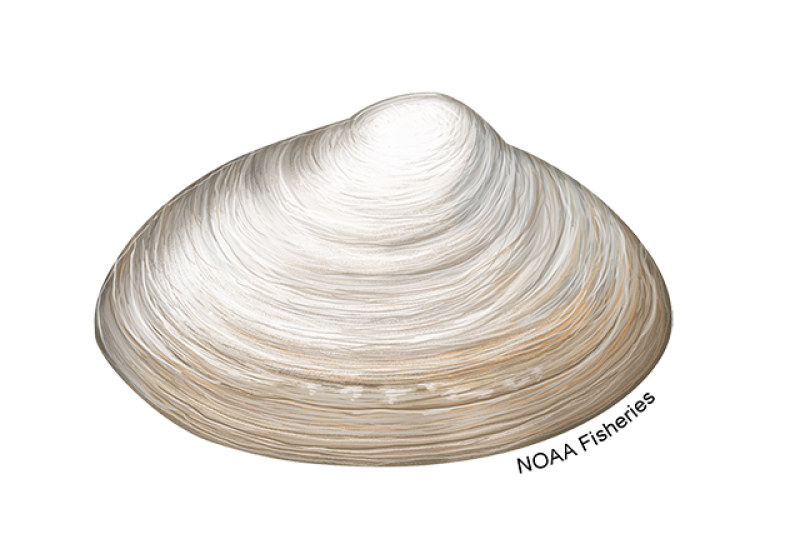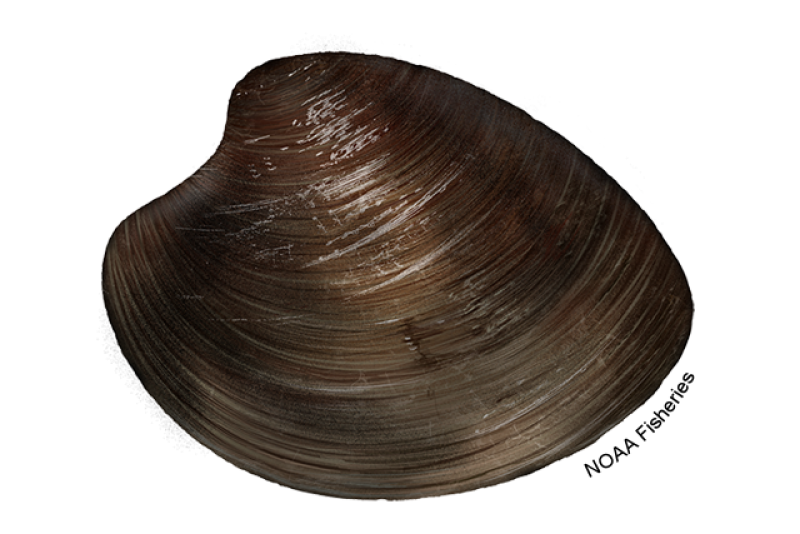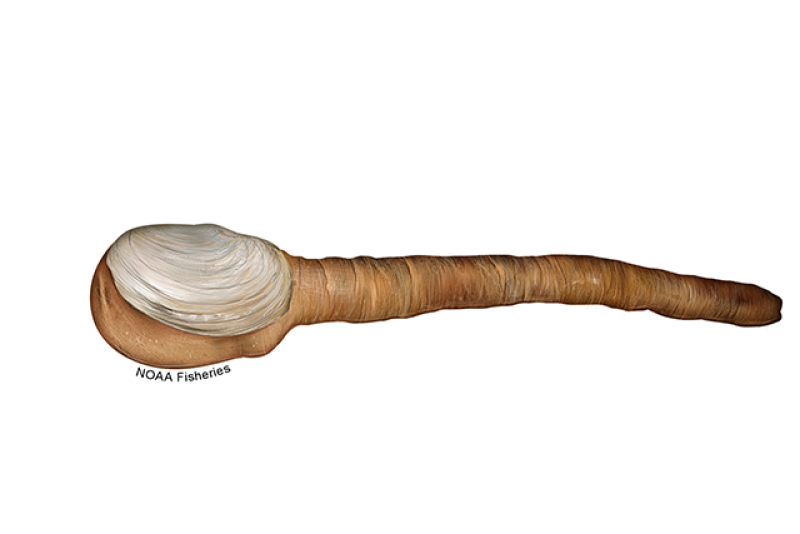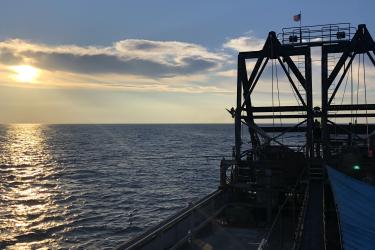
Northern quahog clams harvested in Greenwich, Connecticut. Credit: NOAA Fisheries/Julie Rose
About the Species

Northern quahog clams harvested in Greenwich, Connecticut. Credit: NOAA Fisheries/Julie Rose
The Northern quahog (pronounced coe-hog) is a species of hard-shelled clam. They are found in intertidal and subtidal areas from Nova Scotia, Canada to Florida. Hard clams support extensive commercial aquaculture farming and recreational harvest activities, as well as a commercial wild-capture fishery.
Appearance
- Adult quahogs are just less than 3 inches but can reach up to 5 inches.
- The shell is thick, grey to white in color, and has outer concentric growth rings.
- The inside of the shell is white with violet markings.
- Some hatchery raised clams have dark, zigzag stripes across the shell known as “notata”.
Biology
- Clams are part of the shellfish family. Like oysters, mussels, and scallops they are bivalve mollusks, and have a hinged shell.
- Clams have slow growth rates and can live 12 to 20 years on average and up to 40 years.
- Adults are sessile—they stay in one place—and inhabit both intertidal and subtidal areas.
- Clams burrow into the sediment, leaving only their siphons exposed to feed.
- Quahogs prefer saline water and cannot survive if the salt content is too low.
- Each female can produce between 1 and 5 million eggs during a spawning event.
Scientific Classification
| Kingdom | Animalia | Phylum | Mollusca | Class | Bivalvia | Order | Venerida | Family | Veneridae | Genus | Mercenaria | Species | mercenaria |
|---|
Last updated by NOAA Fisheries on 05/22/2025
Featured News
 Oyster growers harvest farmed shellfish from the Damariscotta River in Maine. NOAA has awarded several grants to small businesses working to develop new tools to advance sustainable U.S. aquaculture. (Image credit: C. Katalinas/ Maine Sea Grant)
Oyster growers harvest farmed shellfish from the Damariscotta River in Maine. NOAA has awarded several grants to small businesses working to develop new tools to advance sustainable U.S. aquaculture. (Image credit: C. Katalinas/ Maine Sea Grant)
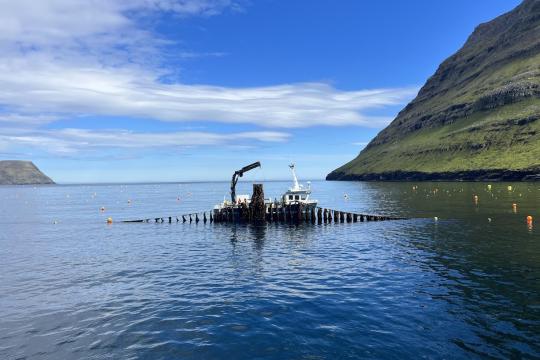
 The NOAA Aquaculture Strategic Plan (2023–2028) includes goals and objectives to sustainably develop the aquaculture industry in the United States. Credit: NOAA Aquaculture Program
The NOAA Aquaculture Strategic Plan (2023–2028) includes goals and objectives to sustainably develop the aquaculture industry in the United States. Credit: NOAA Aquaculture Program
 In Hawaii’s historic Nomilo Loko Iʻa, or Nomilo Fishpond, family-owned Kauaʻi Sea Farms specializes in growing clams, sea cucumbers, and edible seaweed. Credit: Kauaʻi Sea Farms
In Hawaii’s historic Nomilo Loko Iʻa, or Nomilo Fishpond, family-owned Kauaʻi Sea Farms specializes in growing clams, sea cucumbers, and edible seaweed. Credit: Kauaʻi Sea Farms
Seafood Facts

Are Northern Quahogs Sustainable?
U.S. farmed quahogs are a smart seafood choice because they are sustainably grown and harvested under U.S. state and federal regulations.
Availability
Available year-round.
Source
Primarily Virginia, Washington, Florida, Connecticut, and New Jersey.
Taste
Mild flavor, sweet, and briny.
Health Benefits
Clams are an excellent source of omega-3 fatty acids.
Nutrition Facts
Servings: 1; Serving Weight: 100 g (raw); Calories: 74; Protein: 12.77 g; Total Fat: 1 g; Total Saturated Fatty Acids: 0.1 g; Carbohydrate: 0 g; Total Sugars: 0 g; Total Dietary Fiber: 0 g; Cholesterol: 34 mg; Sodium: 56 mgClam Recipes
Looking for some ways to add clams into your rotation? We have you covered with these recipes for baked stuffed clams, clam chowder, and more!

Last updated by NOAA Fisheries on 05/22/2025
Seafood News
 Celebrate Culinary Arts Month with a sustainable seafood recipe for every month of the year.
Celebrate Culinary Arts Month with a sustainable seafood recipe for every month of the year.
What Your Birth Month Says About Your Next Seafood Recipe
 Fresh-caught taʻape on ice. Credit: Conservation International Hawaiʻi.
Fresh-caught taʻape on ice. Credit: Conservation International Hawaiʻi.
Reducing Waste and Feeding Communities in Hawaiʻi with a Whole Fish Approach
 Chef Tyler Hadfield’s Curried Skate Wings with Tomato-Masala Chutney
Chef Tyler Hadfield’s Curried Skate Wings with Tomato-Masala Chutney
Ring In the New Year With These Crowd-Favorite Seafood Recipes
 NOAA Fisheries, in collaboration with Blue Ocean Mariculture, is conducting a multi-year pilot study to evaluate observational methods and tools for studying Hawaiian monk seal behavior. Courtesy of Blue Ocean Mariculture
NOAA Fisheries, in collaboration with Blue Ocean Mariculture, is conducting a multi-year pilot study to evaluate observational methods and tools for studying Hawaiian monk seal behavior. Courtesy of Blue Ocean Mariculture
AI Meets Aquaculture to Study Hawaiian Monk Seal Interactions With Net Pens
Last updated by NOAA Fisheries on 05/22/2025
Last updated by NOAA Fisheries on 05/22/2025
Aquaculture
U.S. farmed quahogs are a smart seafood choice because they are sustainably grown and harvested under U.S. state and federal regulations.

Environmental Impact
Clams provide net environmental benefits by removing excess nutrients and improving water quality.

Feeds
Growing clams requires no feed—they filter phytoplankton directly from the water column.

Farming Methods
Clams are grown in tidal areas. They can be grown directly on the beach bottom or in mesh bags, trays, or pens that are secured to the bottom.

Human Health
Shellfish toxins and bacteria occur naturally in the environment and can cause foodborne illnesses. State and federal regulations require monitoring of farmed clams to ensure they are safe to eat.
Management
- Permitting for shellfish aquaculture is governed by federal, state and local governments.
- The federal agencies involved are NOAA, the Army Corps of Engineers, U.S. Fish & Wildlife Service, U.S. Department of Agriculture, the Environmental Protection Agency, the Food and Drug Administration, the Bureau of Ocean Energy Management, and the Coast Guard.
- Information on shellfish aquaculture permitting can be found in the Shellfish Growers Guide (PDF, 10 pages).
- A variety of shellfish aquaculture tools, including maps and models, are available to coastal managers.
- All fisheries and aquaculture farms in federal waters must adhere to federal regulations including those in the Magnuson-Stevens Fishery Conservation & Management Act, the Endangered Species Act, the National Environmental Policy Act, the Clean Water Act, and the Marine Mammal Protection Act.
Farming Methods
- Juvenile clam (seed) production:
- Clam larvae are bred in hatcheries and are fed a diet of algae until they reach about 1 mm in size.
- Larvae develop shells after 2 days. After 7 to 14 days they lose their swimming ability, settle out, and are moved to containers with mesh that allow water flow over the seed.
- Nursery stage:
- Clams are supplied with seawater containing natural plankton from a nearby estuary.
- Clams are grown in upweller systems until they reach 2 to 5 mm and can then be grown in raceways, mesh bags in the field, or upwellers until they reach 8 to 5 mm.
- Final grow-out:
- Clams are planted in plots or placed in trays, pens, or bags secured to the bottom of intertidal or subtidal areas.
- Clams are grown until they reach harvest size of 50 mm.
Production
In 2019, the United States produced 10.7 million pounds of clams, valued at $122 million.
Environmental Considerations
- Habitat:
- Clam farming has a benign ecological footprint, with little disturbance of sediments or aquatic vegetation during grow-out.
- Some clam growing methods may temporarily cover aquatic vegetation.
- Feeds:
- Once past the larval stage, clams do not need to be fed because they filter their food from the water column.
- Genetics:
- Quahogs are native to the Atlantic and Gulf coasts where they are mainly farmed.
- Juvenile clams are produced in hatcheries that can have limited genetic variation compared to wild populations, but there is little evidence of negative impact on wild clam populations.
Human Health
- Shellfish toxins:
- Shellfish poisoning is an illness that can occur from eating contaminated shellfish.
- Clams can assimilate the toxins that cause shellfish poisoning from the algae on which they feed.
- Early warning systems exist to detect harmful algal blooms that produce toxins.
- New technologies, such as the Environmental Sample Processor, provide near real-time detection of harmful algal species.
- For more information on the prevention and monitoring of harmful algal blooms, read about NOAA's Harmful Algal Bloom forecasting program.
- Pathogenic bacteria:
- The bacteria Vibrio parahaemolyticus (Vp) and Vibrio vulnificus (Vv) occur naturally in the environment and can cause foodborne illness from consuming raw shellfish.
- Ingestion of undercooked or raw shellfish with Vp or Vv can lead to gastrointestinal illness.
- Public health officials monitor shellfish from growing areas to ensure they are safe to eat.
Last updated by NOAA Fisheries on 05/22/2025
Science Overview
- Growth and reproduction:
- The Northeast Fisheries Science Center’s Milford Lab has a history of studying shellfish species for aquaculture, including hard clams and surfclams.
- Ocean acidification:
- Acidification causes a number of changes in water chemistry that may be stressful to estuarine organisms.
- Ocean acidification and its impacts on shellfish are being investigated by NOAA and other labs. For more information, visit NOAA’s Ocean Acidification Program.
Last updated by NOAA Fisheries on 05/22/2025
Outreach & Education
Fisheries of the Northeast
More than 100 species, including finfish, shellfish, urchins, and seaweeds, are landed in the…
Last updated by NOAA Fisheries on 05/22/2025


